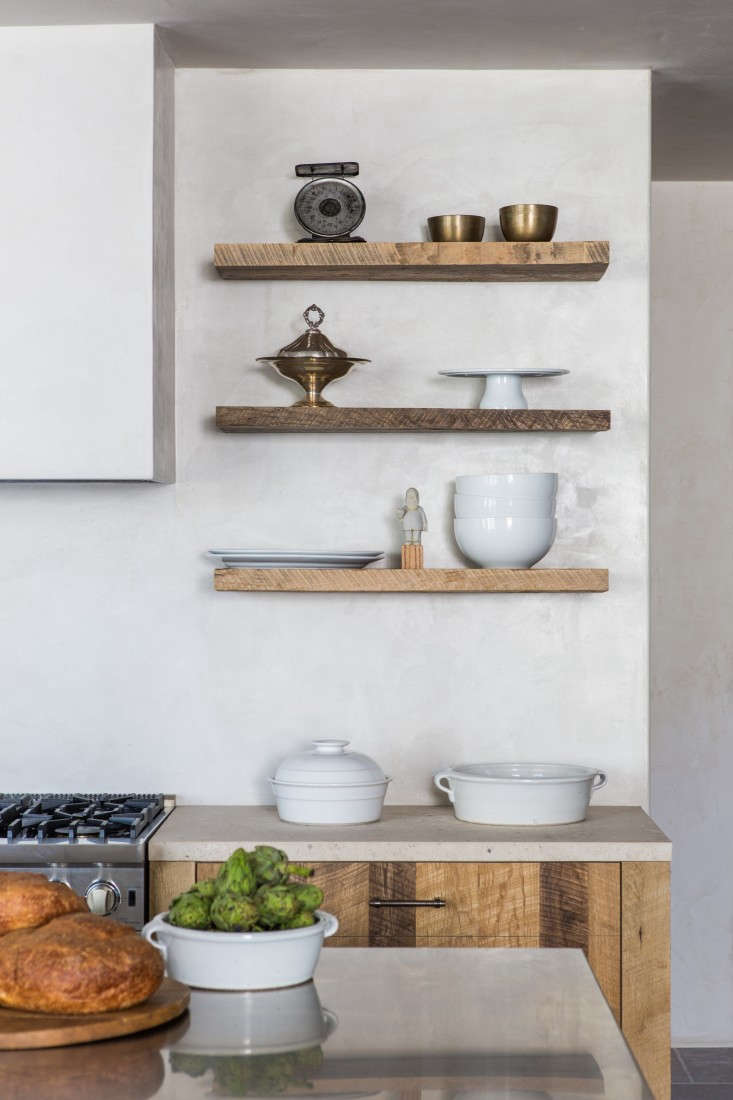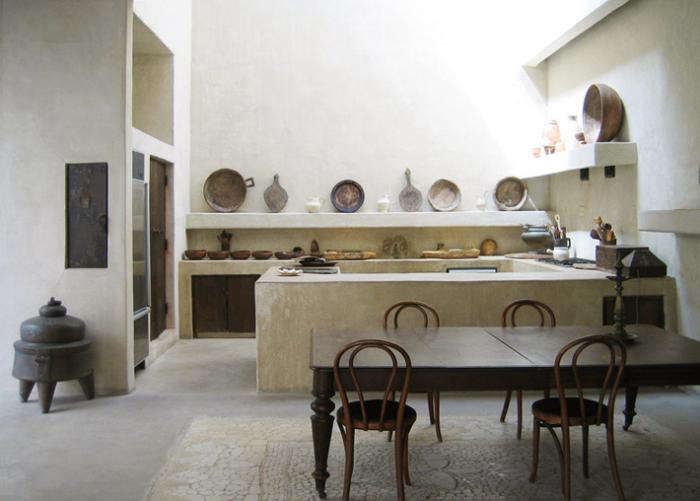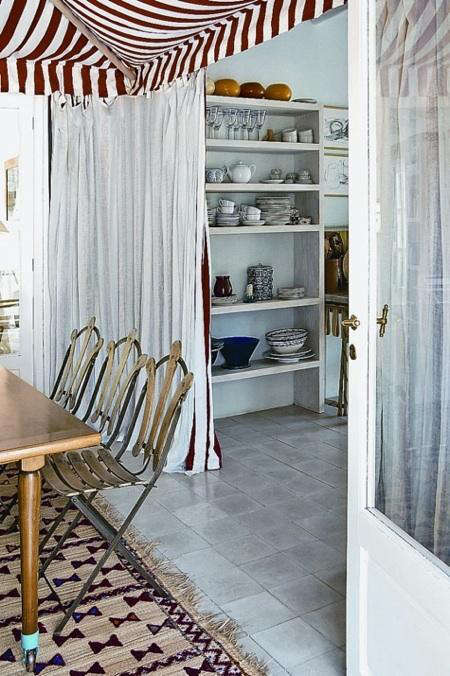We’ve long admired the glossy, seamless walls of traditional Moroccan hammam baths, but knew little about the age-old tadelakt technique used to get them. After spotting the finish in a number of kitchens and baths featured here on Remodelista, we set out to learn more. What is tadelakt exactly, and why the growing popularity? For answers, we turned to Orit Yanai, a San Francisco artisan and expert in the technique. “First of all, it’s gorgeous,” she told us. “And second, people really don’t like dealing with grout.” We’re listening.

What is tadelakt?
Tadelakt is a traditional Moroccan wall surfacing technique composed of lime plaster and black soap made from olives. When the ingredients are combined, a chemical reaction between the two creates a waterproof membrane, making tadelakt walls suitable for wet areas like showers and baths. (If you’ve been so lucky as to have bathed in a traditional Moroccan hammam, the walls were likely tadelakt.)
Why use tadelakt?
Aside from its beauty, arguably the biggest perk to tadelakt is that there are no seams or grout lines in its application. It’s also made from entirely natural materials, does not contain volatile organic compounds, and it’s naturally mold and mildew resistant.

Is tadelakt suitable for anywhere in the house?
“Tadelakt is the Rolls-Royce of lime plaster finishes,” said Yanai, so you’ll want to use it only in places where waterproofing is required—bathrooms mainly, and sometimes kitchens. It can be applied throughout the entire house, notes Yanai, but do that only if you have money to burn; it’s significantly more expensive than standard lime plaster because of the burnishing required to make it waterproof, so use tadelakt in the wet areas and a regular lime plaster finish everywhere else.
Think about it this way: Where you might typically use paint, use regular lime plaster. But where paint won’t do (shower walls, maybe your kitchen backsplash), opt for tadelakt instead.
Is tadelakt durable?
“If people don’t care for it correctly, it can fail,” said Yanai—using harsh chemicals like bleach will destroy the delicate limestone surface. “But if the walls are maintained properly—meaning avoiding harsh cleaners—it’s remarkably easy to maintain.” It can also be waxed yearly to make it additionally resistant to stains.

How should tadelakt be maintained?
Yanai recommends cleaning the tadelakt surface weekly with a sponge, black soap, and water. She always leaves her clients with a starter soap, a list of other suitable cleaning agents, and a written page of clear care instructions to share with family members or house cleaners. “Every time you clean the tadelakt with the black soap,” she said, “you’re softly reconditioning it.”

If tadelakt gets damaged, can it be repaired?
No; tampering with one damaged section will destroy the waterproofing of the entire surface. So if a shower wall is deeply dinged or the surface has been destroyed with bleach, the entire shower panel must be replaced.
However, that’s uncommon, notes Yanai. “In most showers, the main [maintenance] challenge is mildew on the grout lines”—an issue that tadelakt bypasses entirely.
Does tadelakt look like regular lime plaster?
Tadelakt has the organic, handmade look of lime plaster, but with a shinier finish due to the heavy burnishing. “It’s not reflective like Venetian plaster,” said Yanai, “but it’s very smooth to the touch.”

How does tadelakt compare to other finishes, price-wise?
After more than a decade of surveying contractors and tile setters, Yanai has concluded “it’s fair to say tadelakt compares to medium-end tile work.” (Tile, of course, ranges widely in price, as does the cost and quality of installation and the level of skill required to install it.) “Tadelakt cannot beat the price of the lowest-end tile from Home Depot,” said Yanai. “But it can easily beat tile imported from Italy.”
One way to keep costs in check is to use regular lime plaster or American clay plaster elsewhere in the bathroom or kitchen where strict waterproofness is not required; those finishes are naturally mold and mildew resistant but their application is much easier (and therefore cheaper). Use tadelakt only in a shower stall, bath surround, or kitchen backsplash where it will be continually hit with water.
Is tadelakt easy to install?
“Tadelakt is the most difficult, trickiest wall finish to apply if done right,” said Yanai. “Jokers can claim that they do it, but to deliver a long-lasting job, it’s extremely laborious” and requires precise attention to detail. Because humidity and temperature affect the curing time—and the slower the walls cure, the better—Yanai has been known to stay with a wall past midnight, burnishing and babysitting it to keep the finish drying at the right pace. She laughs thinking of the labor required, but, like any artist, she’s committed to her craft: “The result is so gorgeous in the end—that’s why I do it,” she said.

Pros
- There are no seams or grout lines in tadelakt walls.
- Tadelakt is free of hazardous volatile organic compounds (which, due to perfectly legal but highly sneaky labeling, not all products labeled “Zero VOC” actually are; see Remodeling 101: All You Need to Know About VOCs in Paint for a primer).
- Tadelakt is made of entirely natural materials—lime plaster, olive oil soap, and natural pigments.
- Tadelakt is easy to maintain (using approved, gentle cleaners).
- It’s naturally mold and mildew resistant.
- Pigments will not fade over time.
Cons
- Tadelakt is more expensive than entry-level tile or solid surfaces.
- Accidental use of harsh cleaners like bleach will destroy the waterproof surface.
- Once damaged, the tadelakt surface cannot be repaired and must be replaced.
Interested in going the plaster route? Read up on tadelakt and the many options available:
- Remodeling 101: Modern Plaster Walls, Six Ways
- DIY Project: Limewashed Walls for Modern Times
- Expert Advice: 7 Ways to Use Lime Plaster (Hint: It’s Not Just for Walls)
N.B.: This post is an update; the original story ran on April 21, 2017.
Frequently asked questions
What is Moroccan Tadelakt?
Moroccan Tadelakt is a traditional plastering technique that originated in Morocco. It involves applying a special lime-based plaster and polishing it to create a smooth, waterproof, and glossy finish on walls, floors, and other surfaces.
What are the advantages of Moroccan Tadelakt walls?
Moroccan Tadelakt walls offer several advantages. They have a unique and luxurious appearance, provide a seamless and smooth surface, are water-resistant and suitable for wet areas like bathrooms, and offer natural breathability, which can help regulate humidity in the space.
Can Moroccan Tadelakt be used in any room of the house?
Moroccan Tadelakt can be used in various rooms of the house, including bathrooms, kitchens, living rooms, and even exterior walls. It adds a distinctive touch and creates a warm and inviting atmosphere. However, it is not recommended for areas with direct exposure to heavy water spray, such as showers.
How is Moroccan Tadelakt applied?
Moroccan Tadelakt is applied in multiple layers. First, a base coat of lime-based plaster is applied to the wall. Then, a layer of Tadelakt plaster is troweled on and polished with stones or special tools. Finally, a natural soap is applied to enhance the waterproofing and provide the characteristic sheen.
Is Moroccan Tadelakt a DIY-friendly project?
Applying Moroccan Tadelakt requires skill and experience. It is generally not recommended as a DIY project unless you have prior experience with plastering techniques. It's best to hire a professional who is knowledgeable in Tadelakt application to ensure proper execution and a high-quality finish.
Can existing walls be converted to Moroccan Tadelakt?
Existing walls can be converted to Moroccan Tadelakt, but the suitability depends on the condition and type of the existing wall surface. In some cases, preparation work may be required to create a suitable substrate for the Tadelakt application. Consult with a professional to assess the feasibility of converting existing walls.
How do you maintain Moroccan Tadelakt walls?
Moroccan Tadelakt walls require periodic maintenance to retain their appearance and durability. They can be wiped clean with a soft cloth or sponge using mild, non-abrasive cleaners. Additionally, reapplication of a natural soap can be done periodically to maintain the waterproofing qualities.
Is Moroccan Tadelakt environmentally friendly?
Moroccan Tadelakt is considered environmentally friendly as it is made from natural materials, primarily lime and minerals. It is free of harmful chemicals and has low VOC (Volatile Organic Compound) emissions. Its natural properties also contribute to a healthier indoor environment by allowing walls to breathe.
Can Moroccan Tadelakt be used on exterior walls?
Moroccan Tadelakt can be used on exterior walls in suitable climates and conditions. However, it's important to consider factors such as climate, exposure to extreme weather conditions, and the need for additional protection, such as appropriate sealing or maintenance, to ensure its longevity.
Can Moroccan Tadelakt be combined with other wall finishes?
Moroccan Tadelakt can be combined with other wall finishes to create interesting visual contrasts or accents. It can be paired with materials like wood, stone, or tile to add texture and depth to the space. Consult with a design professional to explore creative possibilities for combining Tadelakt with other finishes.






Have a Question or Comment About This Post?
Join the conversation